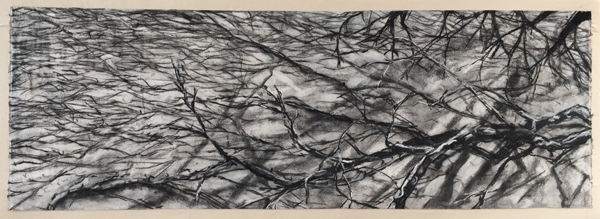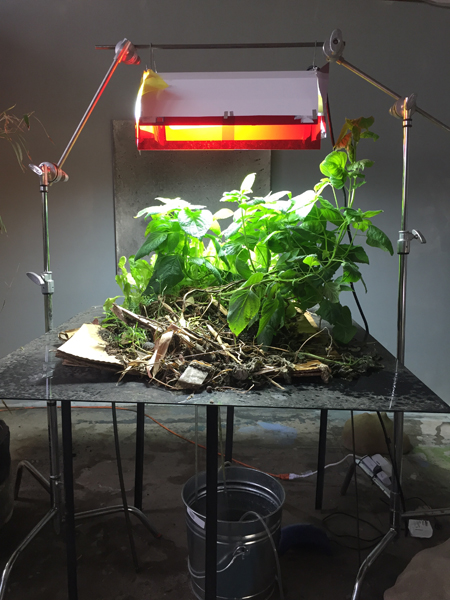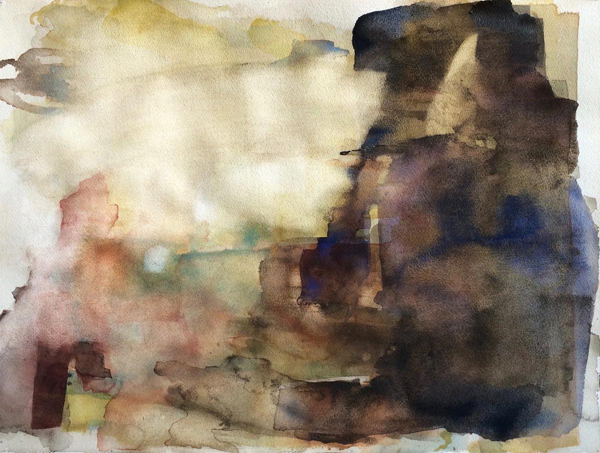July 30th to September 3th
Opening July 30th 4pm to 7pm
Followed by a potluck
Upstairs: Michael Davidson and Joshua Rosenblatt
Downstairs: Gregory Klassen
The Re Institute brings these three artists together in an attempt to paint a whole picture of the word. Each brings a different perspective on nature. Each looks closely at the processes of seeing and the processes of nature at work. They are all from the city of Milwaukee – an incidental factor but, as is often the case, it causes their collective work to be Midwestern in intent, i.e sincere. Sincerity is often today a less-than-admired trait but it is one that allows for truth and a depth of vision.
|
|
MichaelDavidson
I Guess You Had to Be There Foil River and Port of Straws
2016
watercolor on Arches |
|
|
Michael Davidson
Shuffling Along in the Anthropocene.
Sometime, between that cartoon gobbling past, and the incessant digital force feeding of this present, our future flipped. The gleaming whatchamacallit to utopia was uprooted and transplanted 180º; its flower defiled and rotting, its roots bare and clawing for a bite into any foundation and coming up empty handed. Where is chrome and flight and glass and ease and everything faster than fast, free, and available without penance? Who noticed when it was that the fetid substitute emerged not only to supplant, but to delete prior naive versions of itself? Just how did so-much-to-look-forward-to become it-was-nice-while-it-lasted.
There’s no way my wonder of this tiny shift can’t creep into and seep beneath the skin of the page, bake and freeze along the spectrum from hues earthen to acrid, or perfume the way in which a pooled paint stain bleeds, or is cauterized, or is hastily (or lethargically) plugged. Other ill-fitting twins share my studio brain too; the sublime and the stupid, the gorgeous and the hideous, the finessed and the dilapidated.
And what I’m thinking about as I watch an image molt and flesh out is this; how to create a pregnant silence, a loaded muted moment that is- after all- a painting, that can carry and cradle two opposing ideas simultaneously and do it with both passion and doubt. And (on a scale from mild resistance to violent refusal) remain stubbornly yet with great delight in that perfectly awkward limbo. |
|
|
|
|
||
 |
Joshua Rosenblatt 2016 |
|
|
Joshua Rosenblatt
Joshua Rosenblatt's drawings create an in-depth view of seemingly simple places—highlighting details that usually go unnoticed, and incorporating them into documenting changes over time.
These “simple” subject matters can take the form of a mundane hotel room, a quiet interior, a winding patch of vines growing on a wall, as well as other natural and urban settings. These drawings tend to steer clear of the dramatic and distracting focal point in a subject, instead accentuating the quiet details.
For the drawings to convey this, Rosenblatt incorporates several different methods. One of these methods requires him to revisit the same place day after day, and create multiple single works of the slowly changing environment. Each drawing in this series indicates the slight differences in the details of the place—changes in light or weather, shifting seasons—which can only be captured in that particular moment. Rosenblatt’s other primary tactic is to create a panoramic drawing that melds one day into the next—showing the changing environment in a single drawing. In the age of photography, where moments can be captured in an instant, Rosenblatt’s drawings underline a stark contrast. Time moves in his drawings, not in an abrupt moment, but at a slower, more thoughtful pace.
|
||
 |
Gregory Klassen Nature Table November 2014 |
|
|
Gregory Klassen Nature Tables A traditional way of making art is to control the material; painting just the right tone of green in a painting for example. Klassen asks, what happens when the art interprets its environment and renders itself? The Nature Tables are indoor plantings rigged with automatic water and light delivery systems. A simple truss suspends an array of lights over the subject and a unique reservoir and pump system provide a sporadic dose of water. Thus equipped, the project is launched on a course guided by gravity and Heliotropism. His experiment runs counter to the notion that art not only imitates nature, but also completes its deficiencies. Klassen would say that nature is not only imitated by art, but also is made deficient in the face of nature’s completeness. Greg Klassen lets nature do the talking. |
||
|
|
||
|
|
||
|
|
||
